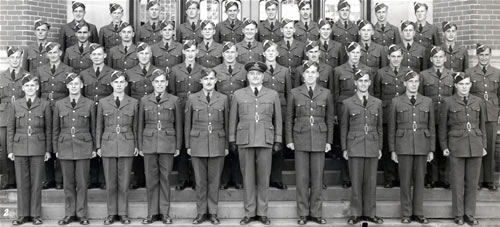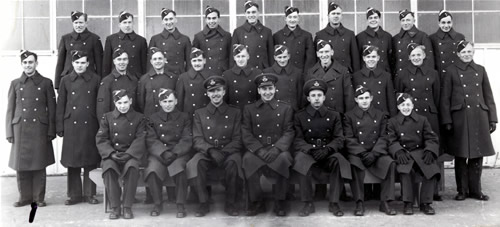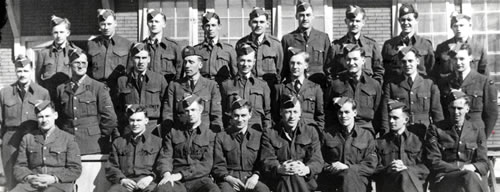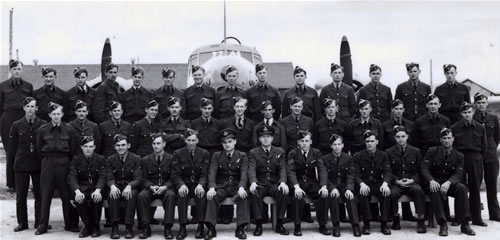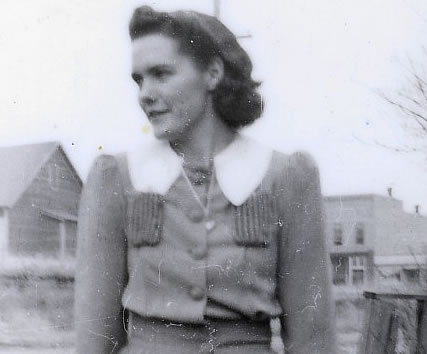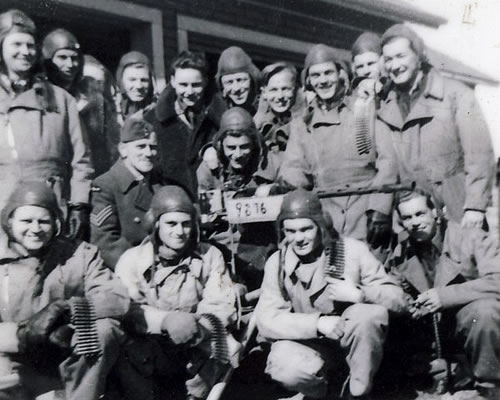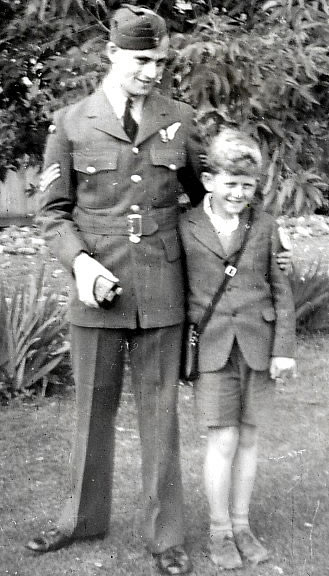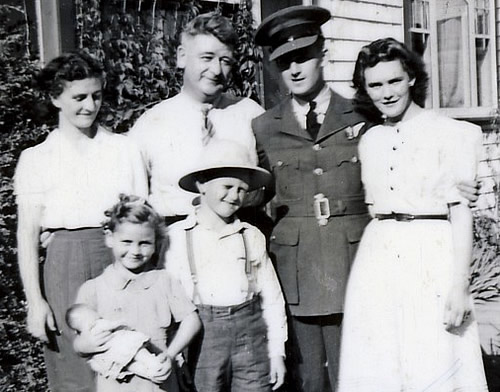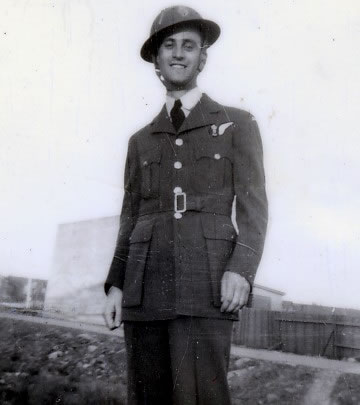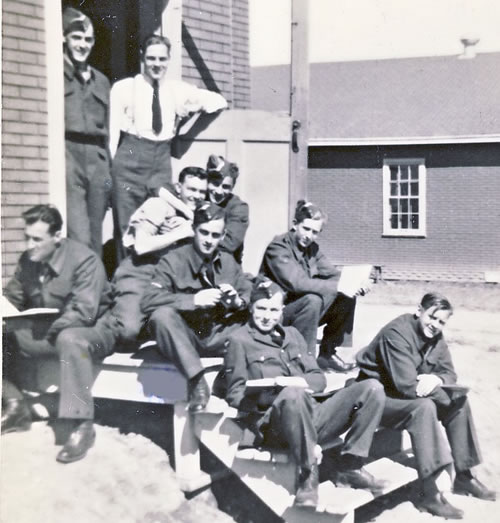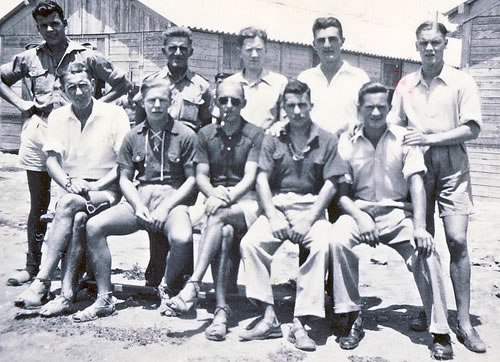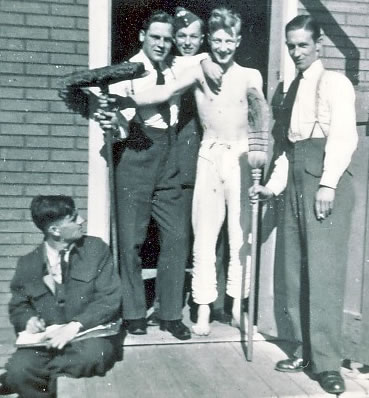Kenneth Tooley Schubert - Preparing for War
Marriage and Training in Canada and England
About Christmas of 1941, the war news was increasingly bad for the Allies and the talk of conscription was strong. I decided that I might as well pick the service I wanted to join, and decided on the Air Force, although my job in the shipyard would have made me exempt from conscription for some time. The day after I had quit the shipyard, the main construction derricks on the berths collapsed. I left Rupert for Vancouver to enlist in the RCAF. In Vancouver, I discovered that my Grade 12 graduation wasn’t good enough for air crew. They only took people with one year of university, so I enrolled in a pre-enlistment school in the old Fairview School of Commerce on Fourth Avenue in Vancouver. I took a four month crash Grade 13 course for university entrance but my course didn’t start until February, so I returned to Ashcroft and spent most of my time in Armstrong.
While I was in Armstrong my cousin, Pat Warner, got married and I was asked to be an usher. The bridesmaid was Helen Jean Watson. We got to know each other fairly well in the two months I was there and decided that we were in love enough to get engaged. The time flew by, and I graduated from the pre-enlistment school not much smarter but much wiser than I was when I went in.
I proceeded to enlist in the RCAF on my birthday, June 10, 1942. I was posted to No. 3 Manning Pool in Edmonton, Alberta, for basic training that encompassed many things, from squad drill on the parade square to washing windows and dishes to laying wire mesh in the local airport to strengthening the runways to handling transports bound for Russia via Alaska. This began my rotation through seven different British Empire air crew training schools for the next year. It was a toughening up period for most of the recruits and, as I was in pretty good physical shape, I did better than a lot of the guys. When our basic training was completed, we still had only a vague idea of what we had signed up for.
On completion of the basic training, I was posted to No. 2 Service Flying Training School at Brandon, Manitoba, for tarmac duty. The duties there were in the order of being a general erk (ground crew). We were there to facilitate the training of student pilots. We acted as guides for the pilots doing night flying. We led them to parking or dispersal spots with flashlights and we flew with them as look-outs when they were practicing instrument flying. On the night flying stint, we would have to wait at the end of the runway for the aircraft to land, sometimes for most of the night. Some nights we had a truck to wait in, other times nothing but the cold and, boy, was it cold. On day duty, we would wait in the crew room until we were needed. Then we would get a misfit parachute harness thrown at us and, always at a run, get to the aircraft. On blind flyer exercises, we would act as lookouts when the instructor and the trainee pilot would get under hoods and, flying only on instruments, away into the wild blue yonder we would go. My job was to yell if any other aircraft looked like it was heading toward us. The first time I flew, we went up to 6,000 feet or so and, all of a sudden, the instructor pulled the aircraft up on its nose and rolled over into a spin. They never bothered to explain what they were up to so, about then, I figured our time was running short. After heading toward the ground for what felt like forever, they pulled out of the spin. It seems they were practicing stall turns. After the first time, I was a veteran and had some idea of what they were going to do next. We erks also got a dollar a day extra for every time we flew.
Photographs of Ken in his uniform at various times during his career in the Royal Canadian Air Force.
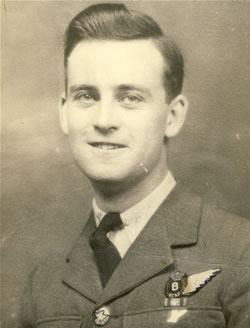
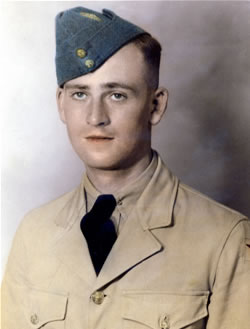
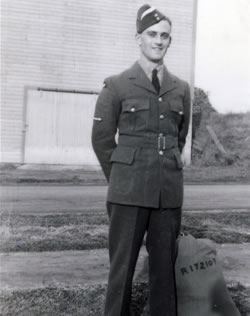
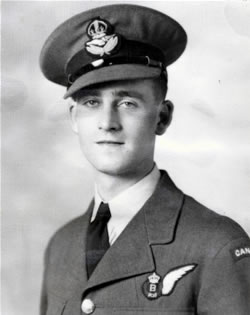
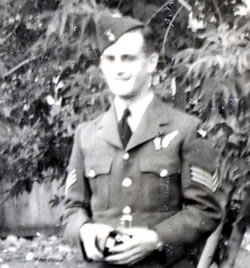
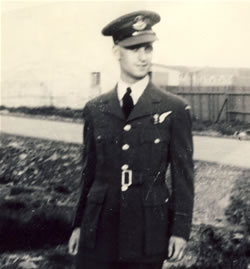
Our flight was next posted to No. 2 Initial Training School at Regina. This was the entrance to the big time. After several weeks of training, it was here that we were divided up for training as pilots, navigators or wireless air-gunners. I was able to make my choice and I signed up for navigation. The next stop was No. 7 Air Observation School at Portage La Prairie as a leading aircraftman. As a LAC, I was permitted to wear the white hat flash to indicate I was an aircrew trainee.
Before reporting to Portage La Prairie, I was given a 96 hour leave and returned to Armstrong where Helen and I were married in the United Church on November 19, 1942. Helen stayed in Armstrong until I found a place for her to board in Portage. She then came to join me. The weather that winter was very cold, with temperatures of -50° F. Helen had to learn to dress properly to keep from getting frost bitten. She consistently got her legs and ears frozen.
The Air Observer’s course was considered a hard one. It covered dead reckoning navigation, astronavigation, signaling by flag, lamp and Morse code, aircraft recognition, map reading and armament. These subjects were covered in the ground school and then practiced in the air. I managed to do pretty well in all of the subjects except for getting enough star shots on the ground for the astronavigation course. We were required to have several hundred shots on various stars. About three quarters of the way through the course, it was evident that I couldn’t make up the required number of star shots as I had been spending too many nights in town with Helen, so I was re-mustered as a bomb aimer. I was posted to the No. 2 Manning Pool in Brandon, Manitoba, to await a course. This was the only unit from which I ever went AWOL, to return to Portage to see Helen. I didn’t get caught, so my presence wasn’t much in demand.
From Brandon, I was posted to the No. 2 Bombing and Gunnery School at Mossbank, Saskatchewan. I couldn’t find accommodation for Helen, so she returned to Armstrong. At Mossbank, I really came into my own. Our flight consisted of men from all walks of life and, as the course progressed, it dawned on me that those with a higher education were not necessarily smarter than the rest of us. In fact, a lawyer and a teacher were at the bottom of the class. We covered all of the courses that had been given at Portage, with more emphasis on bombing, gunnery and aerial photography. I came fourth in the flight, tops in signaling and second in air bombing.
The aircraft used at Mossbank were Bolling-brokes for air gunnery and Avro Ansons for bombing. The accommodations for the gunners in the Bollies were very poor. One gunner was in the turret having a ball, while the other two were stuck in the windowless fuselage getting air sick. The gunner in the turret was trying to hit a drogue towed by a Lysander aircraft. The pilot would turn and slide to give the gunner a moving target at which to fire. The drogue was often hard to hit, so the gunners would stop firing, pretending that their guns were jammed. The pilot would then fly straight and level with the drogue practically sitting on the end of the guns. The gunner would then open up and chop it to bits, aborting the trip for the other gunners. The air bombing was carried out from Avro Ansons, a slow, comfortable aircraft with lots of windows and fresh air. I graduated on May 31, 1943, standing fourth in the flight, and was posted back to Portage La Prairie for the navigation portion of the course.
The navigation section of the course at Portage was easy for me as I had covered most of it before. Our flight graduated as air bomb aimers on July 8, 1943, with the rank of Sergeant. We then went on embarkation leave for ten days. Helen met me in Sicamous and we had a good leave, visiting between Armstrong and Ashcroft. Mae and her children, David and Jeannette, came to Ashcroft. We had a small family reunion with just Jim missing, busy on the North Atlantic. While on leave, I received notification that I had been commissioned as a Pilot Officer. It was the practice to commission the top ten percent of each graduating class.
On completion of my leave, I reported to the embarkation depot in Halifax, Nova Scotia. It was an experience riding the train across the continent – my first trip east of Winnipeg. The train was packed with servicemen and women. We were rationed two to a berth. Take your pick, sleep with a stranger or sleep in shifts – many of us stayed up most of the night. If I remember correctly, it took three days and four nights to get to Halifax. In Halifax, we met our first tight security and the war got closer still. It was one of medical checks, photographs and kit checks. While in Halifax, I developed huge hives all over my body. None of the doctor’s efforts seemed to do much good. As a last resort, the doctor drew blood out of my arm and shot it into my hip – the hives disappeared like magic.
The long awaited embarkation date of August 2, 1943, finally arrived. We were loaded onto a troop train and arrived the next morning in New York City. We didn’t get much more than a look at the skyline before being hustled aboard the SS Aquitania. She was at one time the winner of the Atlantic Blue Ribbon, which is awarded to the luxury liner making the fastest crossing of the Atlantic. She wasn’t very luxurious when we boarded her. She had been stripped of all of her fancy trimmings, and bunks had been built into every available space. Staterooms formerly equipped with one double bed now had twelve double deck bunks, and this was in officer country, the best she had to offer. On the opposite side of the pier from the Aquitania, the Normandy lay on her side on the bottom of the harbour. She had been the pride of the French passenger fleet, the largest passenger ship in the world next to the Queen Elizabeth. She had just been converted to a troop ship when she was sabotaged and burned. Even lying on her side on the bottom, she towered over the docks.
The Aquitania was one of the few troop ships considered too fast for the enemy submarines to catch, so she went unescorted across the Atlantic. Travelling full bore, she altered course every five minutes or so to throw any subs off target. She heeled over on every turn, with the rivets squealing as if she was going to fall apart. As an officer, I was detailed as a fire marshal and assigned to patrol G-Deck, which was just under the water line. On this deck, a battalion of Negroes was billeted. If they had decided to smoke in this restricted area, I doubt that I would have had much control over them. There were approximately 12,000 troops on the ship. The crossing was made without incident in six days from New York to Greenock, just outside of Glasgow, Scotland.
We boarded a troop train in Greenock and, 18 hours later were in Bournemouth, a beautiful resort town on the English Channel. It was now a holding depot for RCAF air crews waiting for postings to advanced training units. The town had been bombed and signs of war were evident all around, with burned buildings and barbed wire along the beaches.
On September 3, 1943, I arrived at the Advanced Flying Unit at Wigtown, which is a few miles north of Glasgow. This was an RAF station and, since we were the only RCAF flight there, it created some friction and not a few fights. Our training was intense for a month. We were either in the bombing simulators, link trainers or in the air, bombing infrared targets in shipping and industrial areas in England or Ireland. My first view of Ireland was really something. It looked like a big golf course from the air, with various shades of green and blue lakes and rivers. The hope of all of the crews was to have an emergency landing on the Isle of Mann where there was no rationing. We flew over it on practically every flight out of Wigtown but never had an opportunity to land. Our month at Wigtown was soon over, and we were posted to the No. 22 Operational Training Unit at Gaydon, near Warwick, a few miles south of Birmingham and close to Stratford on Avon.
Our posting to Gaydon was our introduction to operational aircraft and being assigned permanently to a crew. I was assigned to an existing crew consisting of Pilot Officer Bill Wilson, pilot, Flight Sergeant Butch MacStocker, navigator, and Warrant Officer Second Class Al Casey, wireless air gunner. These fellows had been flying Hampden aircraft at Patricia Bay, near Victoria, B.C., in Coastal Command. One day, they had evidently been flying low and tipped their propellers into a wave, but had managed to re-turn to their base with bent props. They were drafted overseas to Bomber Command post haste. I was added to the crew as a Pilot Officer, bomb aimer; also added were Sergeant Grant Bull, rear gunner, Sergeant Harry Walker, mid-upper gunner, and Sergeant Jack Lee, flight engineer. Jack was the only RAF type in the crew, and I was the only Canadian that didn’t come from Ontario.
At Gaydon, the crew had to learn to work together as a unit and also to learn how to fly a light bomber – in our case, it was a Wellington. This had been an old work horse since early in the war. It had twin radial engines and was constructed on a geodetic principle – it was a mass of crisscross framework covered with fabric. The armaments consisted of four 0.030 Browning machine guns in the rear turret and two in the nose turret. It carried three tons of bombs in the fuselage bomb bay.
The first problem was for our pilot to learn to fly this kite – it was much heavier than any of those we had been in previously. I flew as rear gunner and bomb aimer during this conversion period while the rest of the crew attended ground school. My main job was map reading from the bomb aimer’s position to keep the pilot on the right approach to the runway. There was so much industrial haze from the Birmingham factories that the pilot couldn’t see the ground from his position. We had about a week of circuits and bumps (touch-and-go landings) for the pilot to get the feel of things before the rest of the crew joined us and we proceeded to learn our individual functions as a crew. On November 15, we started out as a crew and, from that date, we flew every time we could get an airworthy aircraft. When there were no aircraft available, we spent the time in the link trainer, bombing simulator and gunnery range or in the ground school. My job in the crew now consisted of bomb aiming, second pilot on takeoff and landing, and taking fixes for the navigator and nose gunner.
We sometimes flew training flights over London. The British had a system of waving their search lights in one direction to indicate to training aircraft which way they were to leave an area that was about to come under enemy attack. One night, we had just arrived when the search lights started to wave in one direction. All allied aircraft were equipped with a radio transmitter that, when turned on, sent out a signal to identify it as a friend. Some gremlin had turned our transmitter off and, as soon as we discovered this, turned it on, all the search lights went out. If we hadn’t gotten it on, we may have been target practice for the Army.
On January 1, 1944, we were dispatched on our first trip over enemy territory to Rennes in France. It was a nickel trip – we had a load of 30 containers of leaflets wishing the people of Rennes a Happy New Year and good cheer. We were all set for take off and had started down the runway when it became evident that one engine was not giving enough power. Bill made the decision to cut the throttles and tried to brake. We took to the overshoot area as if we were never going to stop, but the wheels finally dropped into the perimeter ditch just short of the boundary fence. The crash truck was along side nearly as soon as we had stopped rolling and had us unloaded and into the spare aircraft in no time. We finally got airborne and away on our first not-for-fun trip.
Our course took us between the Channel Isles, which were held by the Germans. This allowed them to shoot at us from both sides, but Bill had learned his lessons well and got us past this hot spot without trouble. When we approached Rennes, I took control from the bomb aimer’s position and, for the first time, could see the guns below firing and the flack mushrooming around us. Boy, that sure made me feel that I was in the wrong spot – I couldn’t make myself small enough to suit me. We ran up to the aiming point, released the leaflets, and turned onto our return course. The anti-aircraft gunners must have thought we were sitting ducks, but Bill caught on fast and put us into a dive that threw the flack above us. We got back to base without a scratch and quite a bit wiser after four and a half hours. My bombing average error was now 95 yards compared to 100.5 yards when I left Mossbank. My rating was above average.
One of the highlights when I was at Gaydon was receiving word from Dad that Jim had escaped from a prisoner of war camp in northern Italy and would soon be in Britain. I kept in contact with B.C. House and the Marconi Radio Company office in London for word of his arrival. He had been on a ship that had been bombed south of Italy while trying to break the blockade of Malta to bring supplies to that island. The crew had taken to the lifeboats and crossed the Mediterranean to North Africa where they were interned by the Vichy French. They had been moved several times as Montgomery and Rommel fought for the area, finally landing in a prison camp in the north of Italy. His story could fill a book, and should. When he arrived and was cleared in London, he was able to visit me at Warwick. I was sure glad to see him alive, although not in too good health. His captivity had been a great worry to Mom and Dad.
We graduated from Gaydon at the end of January, 1944, and were given two weeks leave. I was able to visit my Tooley relatives in Stoney Stratford and my Allen relatives in Northampton as well as take in some of the sights in London. The war was going hot and heavy in London, with raids every night, search lights, bombs, flack and fires and many buildings gutted and planes shot down. The local people packed the subway tubes and slept on the platforms or on tiered bunks against the walls of the tubes. They seemed to have gotten used to sleeping with the subway trains roaring into the station only a few feet from them.
When our leave expired, we reported to an RAF station at Topcliffe in Yorkshire. This was a survival training unit operated by the British Army. Our discipline to now had been child’s play – this outfit should have had machines, not men. We Canadians stuck together and survived. I think the cocky little English Sergeant Major with the brass ball on the end of his staff must have had a few laughs (when we were out of his sight). What a guy, you could hear him yelling a mile away. Everything was done on the double at that place.
We were posted to the No. 1664 Conversion Unit at Dishforth, Yorkshire, to learn how to handle four engine heavy bombers – in our case, Halifax Mark II’s. The night we arrived on the base, a Halifax that had been on a mine laying mission came in and dropped a hung-up mine on landing and blew itself up. The element of risk in flying became more apparent at this station. The German’s often flew back to England in the stream of bombers and shot them up as they came in to land.
The Halifaxes used at this unit were kites that weren’t good enough for operational flying. They were obsolete, well worn from operations, underpowered, and would go into a spin at any time without cause. The instructors had a tendency to do most of their instructing from the ground and watched the trainee crews do their stuff from that vantage point. There were quite a few accidents, and most of the time there wasn’t an aircraft that we were able to get into the air. The training followed the pattern we used when we converted to Wellingtons. I flew with the pilot as bomb aimer and rear gunner while the rest of the crew attended ground school. The pilot had no trouble converting. We flew practice flights as a crew for a couple of weeks, and then we were off to the squadron. The usual rumors of where we were going and what kind of aircraft we would have were running rampant. All bets were on a Lancaster.
- Date modified:


